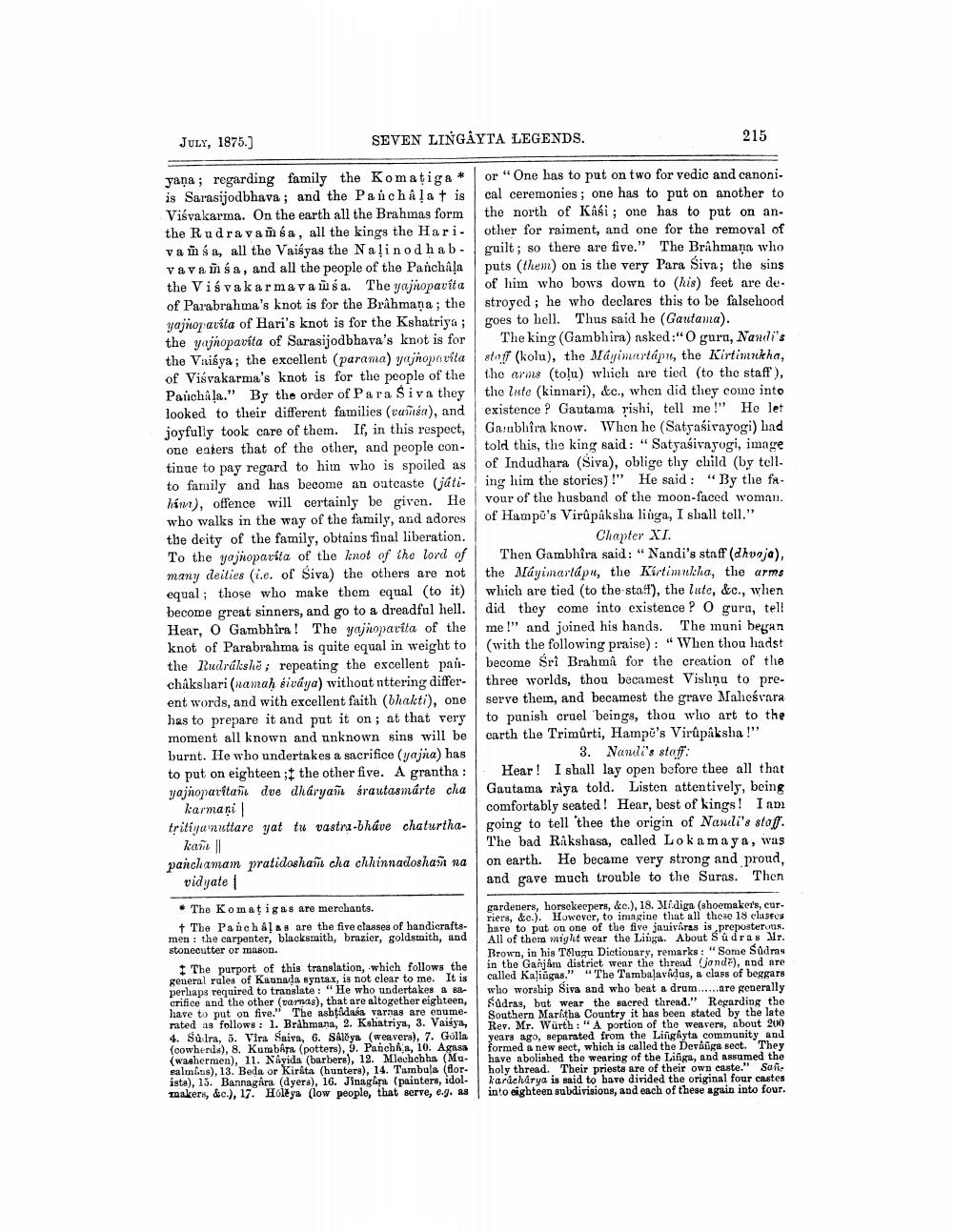________________
JULY, 1875.]
SEVEN LINGAYTA LEGENDS.
215
yaņa; regarding family the Komatiga * or "One has to put on two for vedic and canoni. is Sarasijodbhava; and the Panchala + is cal ceremonies; one has to put on another to Viśvakarma. On the earth all the Brahmas form the north of Kasi; one has to put on anthe Rudra va més, all the kings the Hari. other for raiment, and one for the removal of vam sa, all the Vaiśyas the Naļinod hab. guilt; so there are five." The Brahmana who vava isa, and all the people of the Pancha!a puts (them) on is the very Para Siva; the sins the Vis vakarma va isa. The yajnopavita of him who bows down to his feet are de. of Parabrahma's knot is for the Brahmaņa; the stroyed; he who declares this to be falsehood yajnoparita of Hari's knot is for the Kshatriya; goes to hell. Thus said he (Gautama). the yjnopavíta of Sarasijodbhava's knot is for The king (Gambhira) asked:"O guru, Nandi's the Vaisya; the excellent (parama) yajnopavila staff (kolu), the Mayimurtapu, the Kirtimukha, of Višvakarma's knot is for the people of the the arms (tolu) which are tied (to the staff), Panchala." By the order of Para Siva they the lute (kinnari), &c., when did they come into looked to their different families (visa), and existence ? Gautama fishi, tell me!" He let joyfully took care of them. If, in this respect, Gayubhira know. When he (Satyasirayogi) had one eaters that of the other, and people con- told this, the king said: "Satyasivayogi, image tinue to pay regard to him who is spoiled as of Indudhara (Siva), oblige thy child (by tell. to family and has become an outcaste (játi- ing him the stories) !" He said: "By the fahím), offence will certainly be given. He vour of the husband of the moon-faced woman. who walks in the way of the family, and adores of Hampu's Virupaksha linga, I shall tell." the deity of the family, obtains final liberation.
Chapter XI. To the yajioparita of the knot of the Lord of Then Gambhira said: " Nandi's staff (dhuaja), many deities (i.e. of Siva) the others are not the Máyimartápu, the Kirtimukha, the arms equal; those who make them equal (to it) which are tied (to the staff), the lute, &c., when become great sinners, and go to a dreadfal hell. did they come into existence ? O gura, tell Hear, O Gambhira! The yajioparita of the me!" and joined his hands. The muni began knot of Parabrahma is quite equal in weight to (with the following praise): "When thou hadst the Rudrákshē; repeating the excellent pan become Sri Brahmîi for the creation of the chakshari (namah siváya) without nttering differ- three worlds, thou becamest Visliņu to preent words, and with excellent faith (bhakti), one serve thein, and becamest the grave Naleśvara has to prepare it and put it on; at that very to punish cruel beings, thou who art to the moment all known and unknown sins will be carth the Trimurti, Hampi's Virupaksha!" burnt. He who undertakes a sacrifice (yajia) has
3. Nanuli's staff: to put on eighteen :I the other five. A grantha : - Hear! I shall lay open before thee all that yajnoparital dve dharyai srautasmdrte cha Gautama raya told. Listen attentively, being karmari
comfortably seated! Hear, best of kings! Inm tritiya nuttare yat tu vastra-bháve chaturtha- going to tell thee the origin of Naneli's staff. kай |
The bad Rakshasa, called Lokamaya, was panchamam pratidosha cha chhinnadoshan na on earth. He became very strong and proud, vidyate
and gave much trouble to the Suras. Then
• The Komatigas are merchants.
+ The Paneh alas are the five classes of handicrafts. men : the carpenter, blacksmith, brazier, goldsmith, and stonecutter or mason.
1 The purport of this translation, which follows the general rules of Kaunada syntax, is not clear to me. It is perhaps required to translate : "He who undertakes a sacrifice and the other (varas), that are altogether eighteen, have to put on five." The ashtAdaśa varnas are enumerated as follows: 1. Brahmana, 2. Kshatriya, 3. Vaisya, 4. Sulra, 3. Vira Saiva, 6. Salčya (weavers), 7. Gilla (cowherds), 8. Kumbara (potters), 9. Pancha, 10. Agasa (washermen), 11. Náyida (barbers), 12. Mlechchha (Musalm(ns), 13. Beda or Kiráta (hunters), 14. Tambula (florista), 15. Bannagára (dyers), 16. Jinagkra (painters, idolmakers, &c.), 17. Holèya (low people, that serve, e.g. as
gardeners, horsekeepers, &c.), 18. Mr.diga (shoemaker's, cur. riers, &c.). However, to imagine that all these 18 clasics hare to put on one of the five jaziváras is preposteruns. All of them might wear the Linga. About Sudras Jr. Brown, in his Telugu Dictionary, remarks: "Some Sams in the Ganjam district wear the thrend jond), and are called Kalingas." "The Tambalavadus, a class of beggars who worship Siva and who beat a drum......are generally Sudras, but wear the sacred thread." Regarding the Southern Maratha Country it has been stated by the late Rev. Mr. Würth: "A portion of the wearers, about 200 years ago, separated from the Lingayta community and formed a new sect, which is called the Devauga sect. They have abolished the wearing of the Lifiga, and assumed the holy thread. Their priests are of their own caste." Safe karacharya is said to bave divided the original four castes into eighteen subdivisions, and each of these again into four.




